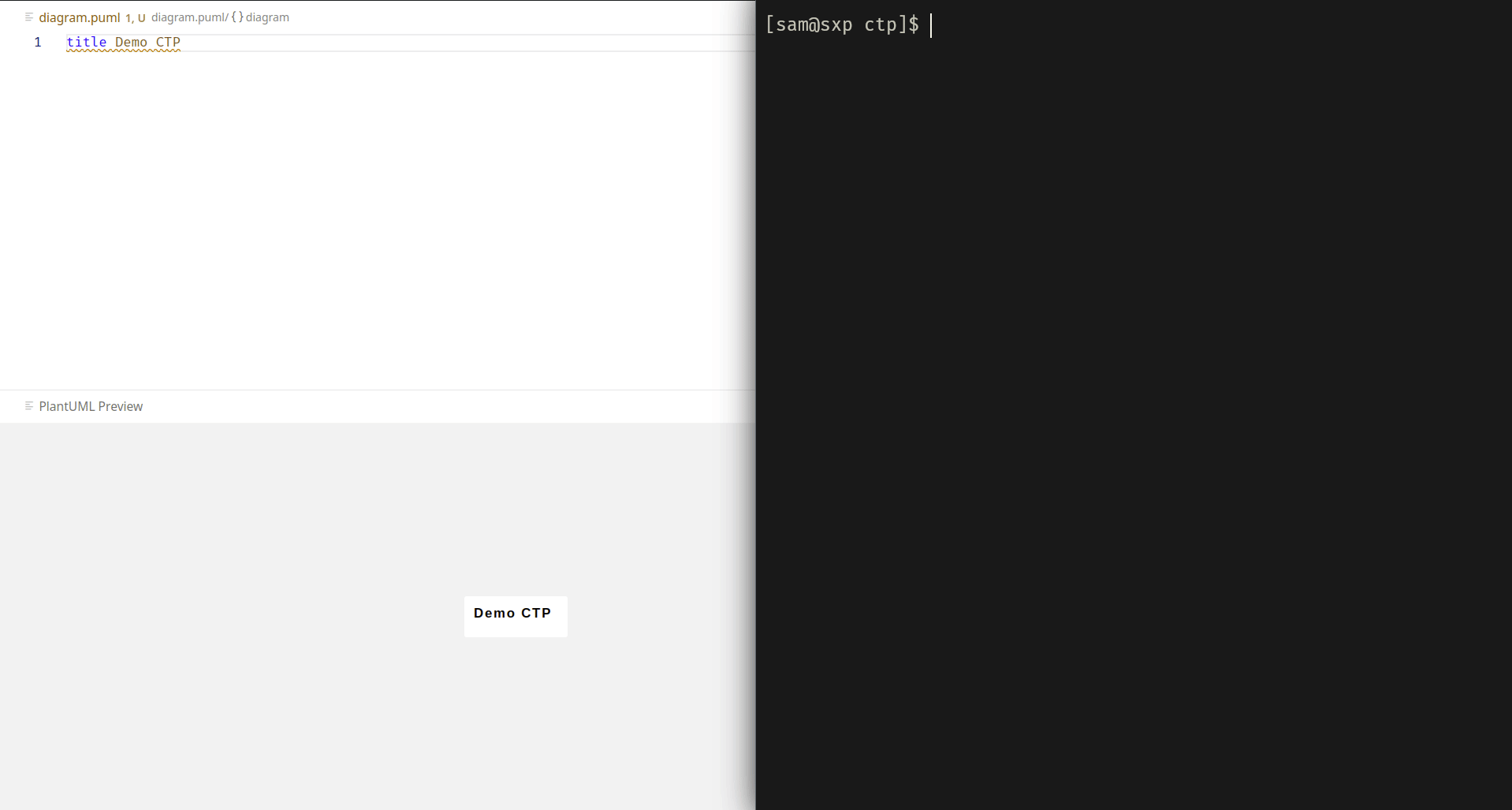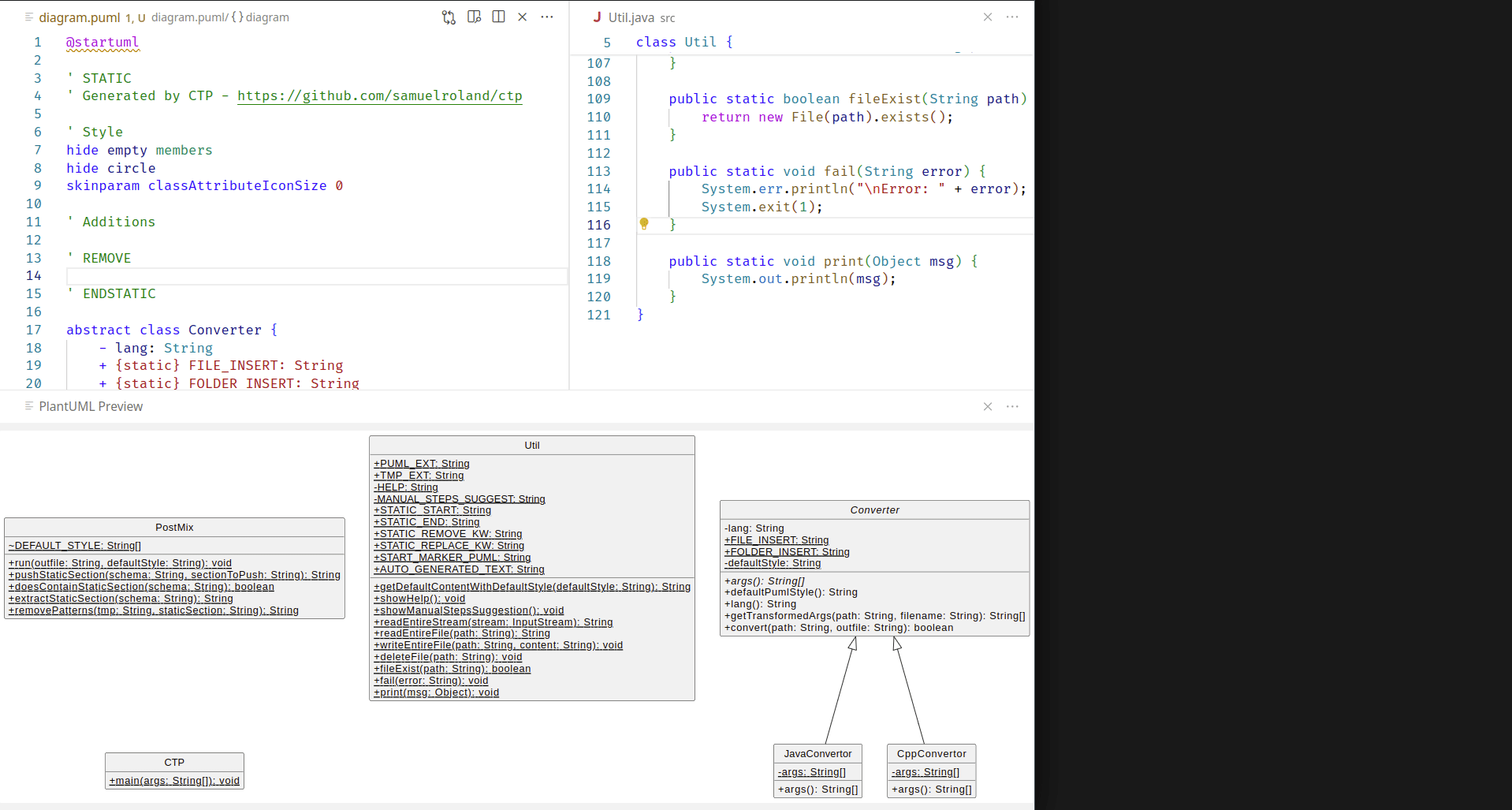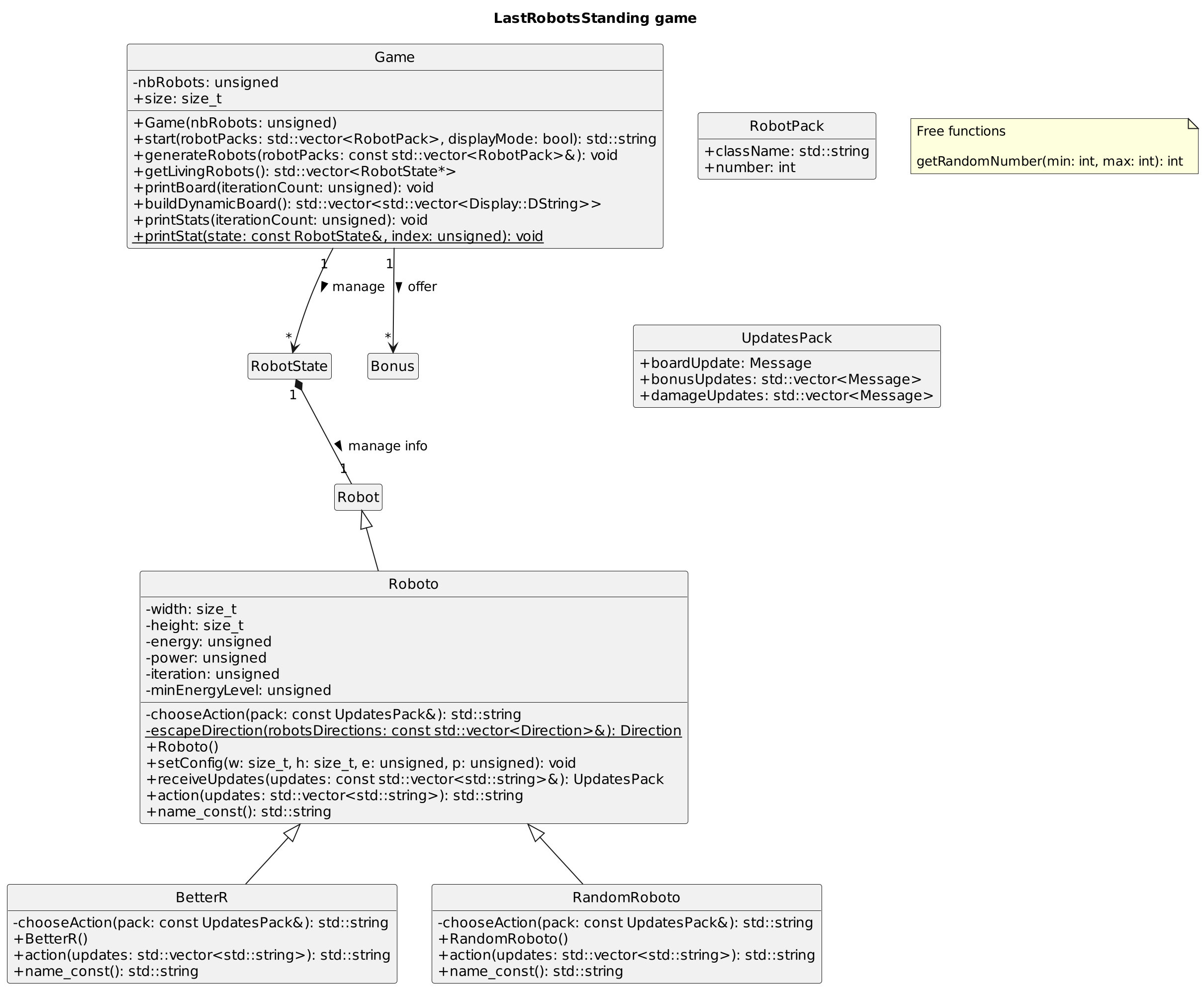$ ctp
CTP - Code To PlantUML - v0.1
Usage: ctp [lang] [path] [output]
Languages: java | cpp
Path: a path to a folder to scan (must be inside the current directory)
Output: the name of output diagram file (extension .puml is added if missing)
Examples:
ctp cpp src diagram
ctp cpp . classdiagram
ctp java app/src/main/org/example/stack stack
ctp java src/ project.puml
Repository: https://github.com/samuelroland/ctp
Docs: See README.md in repositoryWe have a folder structure with a few Java classes in src, the entrypoint is CTP.java
.
├── ...
└── src
├── Converter.java
├── CppConverter.java
├── CTP.java
├── JavaConverter.java
├── PostMix.java
└── Util.java
By running ctp java src diagram it generates a diagram.puml file:
Then inside the static section we can make changes to the style, add missing associations. If we change the code (here we rename Util.fail() into Util.error()) we can safely regenerate the diagram the static section will be preserved !
See the generated file in examples/ctp.puml and exported image
I took a random C++ we made at school, let's clone the repos and run CTP:
git clone https://github.com/HEIGVD-PRG1-F-2022/lab06-lastrobotstanding-roboto.git
cd lab06-lastrobotstanding-roboto
ctp cpp . diagram
It gives us this raw diagram
We want a title, scale the image, and add hidden links to rearrange the diagram. Let's do it inside the static section after the default style:
' Style
hide empty members
hide circle
skinparam classAttributeIconSize 0
+ scale 2
+ title LastRobotsStanding game
' Additions
+ RobotState "1"*--"1" Robot: manage info >
+ Game -[hidden]- Roboto
+ RobotPack -[hidden]- UpdatesPack
+ Robot <|-- RobotoIn generated diagram, we want to remove these 2 attributes and use 2 associations instead
class Game {
- robots: std::vector<RobotState>
- boni: std::vector<Bonus>
so we add these 2 unique patterns under REMOVE (those are external class in a dependency, this is why it is not in this schema)
' REMOVE
+ ' - robots: std::vector<RobotState>
+ ' - boni: std::vector<Bonus>and we add the associations manually
' Additions
+ Game "1"-->"*" RobotState: manage >
+ Game "1"-->"*" Bonus: offer >
RobotState "1"*--"1" Robot: manage info >
Game -[hidden]- Roboto
RobotPack -[hidden]- UpdatesPack
Robot <|-- RobotoWe need to run generation again to have the remove patterns applied: ctp cpp . diagram and bam, the 2 lines have been removed, here is the final diagram.
Look at the source file if needed: examples/cpp-example-2.puml
I support languages when I need it. When I found the best converter, as it generally works for 95% of my needs, I do a fork to adapt it. Then I integrate them here, so they can be easily ran and support post-processing features. converters are far from being perfect, they don't support some modern syntax and do don't generate associations.
- Fork of converter: https://github.com/samuelroland/plantuml-parser
- Modifications: see README of given repos
- License: Apache-2.0
- Note: Thanks a lot to @shuzijun for your effort in making in this nice tool, this got me started with this little project !
- Fork of converter: https://github.com/samuelroland/hpp2plantuml
- Modifications: see README of given repos
- License: MIT - Copyright (c) 2016 T
- Note: Thanks a lot to @thibaultmarin for this nice converter, it's really useful !
- They are known bugs, see the README
- Warning: only .h and .hpp (not .cpp) files are parsed in given folder ! Make sure free functions are declared in a header file and don't use the syntax
int a{}as it will ignore the variable.
I know this is not a straightforward setup but is the best I can do in the short time I invest in this mini project...
- Clone the repository
git clone git@github.com:samuelroland/ctp.git
- Build the Docker image
docker build -t ctp . - Run the CLI
Note: We mount the current folder to
/codein container, to give it access to the current folder. Therefore, the given path (first argument) needs to bedocker run -v .:/code ctp
- Instead of typing
docker run -v .:/code ctpevery time, I recommend to setup an alias like this. You can persist this alias in your shell config (i.e..bashrc)You can now just run it, here is an example for a Java project with all classes inside src/main and an output diagram named diagram.puml.# Standard version alias ctp="docker run -v .:/code ctp" # Or if you run docker as root ctp(){ sudo docker run -v .:/code ctp "$@" if [ -f "$3.puml" ]; then sudo chown $USER "$3.puml" fi }
ctp java src/main diagram
- Make sure to remove do the manual work after generation (remove existing incorrect/incomplete associations, add missing one, changing style, add notes, ...)
See more options and usage below.
Warning: the CLI erase the latest diagram file, make sure you didn't change anything outside the static section or that you can recover it. Ex: ctp java src/ project will erase project.puml and project.puml.tmp.
Once you generate your diagram once, you probably want to make some small. If you directly edit your schema, you will lose your changes at next schema generation because the file is just erased each time. I defined a static section in generated file, meaning a section that is not erased during regeneration and can contain special actions on the dynamic part.
At the start of the schema you should find a marker ' STATIC and an ending marker ' ENDSTATIC. You can safely add lines inside. You probably noticed the ' REMOVE line, after this you can add regex patterns (in comments so PlantUML don't consider them) that will be removed in the dynamic part. For example to remove a line like - currentTime: Time you could write ' - .*: Time\n. This is particularly useful to remove some existing lines like associations you want to change !
' STATIC
' Generated by CTP - https://github.com/samuelroland/ctp
' Style
hide empty members
hide circle
skinparam classAttributeIconSize 0
' Additions
' REMOVE
' ENDSTATIC
High level steps overview:
- Check CLI args and show errors if needed
- The output file is a ".tmp" variant
- If lang is
java- Call
plantuml-parser-cliwith given arguments as -f and -o, with default params related to schema settings.
- Call
- If lang is
cpp- Call hpp2toplantuml to parse only headers file
- Run post mix, read tmp file and possibly existing non tmp file
- Push the default section text at the start in case there is no existing non tmp file or no static section has been found
- Reuse the existing section, push it at the start, apply removal patterns.
- Save the final text in non tmp file
In case this repository is updated, you can pull changes and do a rebuild
git pull
docker build -t ctp .docker image rm ctp
# and remove your alias ctpI support the languages I need, Need to support another converter for another programming language ? Need to tweak the default style or enhance the post mix ? Here are a few hints on how you can do it. If you consider your changes useful, please open a PR here.
New language support
- Find or create a new plantuml converter for this language. It needs to have a CLI associated to be called by
ctp. - Eventually fork it to adapt it to your own needs
- Create a new converter class that extends
Convertor - Use it in
CTP.main()insideconvertorsvariable - Define a constructor to call parent constructor with a language identifier
- Define the arguments needed (included the name of the external CLI) with
FILE_INSERTandFOLDER_INSERTconstants to indicate where to insert those 2 info - If needed, override
defaultPumlStyle()with more or other default styles - Build/Install your external CLI in the Dockerfile``, so your command can be called from inside the container.
- Build the
Dockerfileand try it !
Here is an example with how the C++ converter is defined (CLI is called hpp2plantuml)
class CppConvertor extends Converter {
private static final String[] args = new String[] {
"hpp2plantuml",
"-i", Converter.FOLDER_INSERT + "/**/*.h",
"-i", Converter.FOLDER_INSERT + "/**/*.hpp",
"-o", Converter.FILE_INSERT };
CppConvertor() {
super("cpp"); //this key is what should be given as first param when calling ctp
}
@Override
public String[] args() {
return args;
}
}Change supported converters to your forks
Just edit Dockerfile to clone your forks instead mines :)
I don't plan to maintain this project, I want to "just make it work" and not expand it further. But I'm happy to document how to use it and how it works in case it's useful to someone else in my class or outside. I guess a lot of IT students are learning OOP and need to have up-to-date UML diagrams... If you want to do other changes or support other languages, feel free to contribute or continue in your own fork. If you want to take maintenance burden here, feel free to open an issue to discuss this :)
TODO: implement REPLACE keyword
TODO: implement automatic associations generation with attribute name and correct cardinality, a not so basic task. Wanna help ?
The code present in this repository is released under MIT. The licenses of supported converters is independent of this license as we are running the converters as separated CLIs (they are separated processes, ctp is just a glue around it to easily run them).





